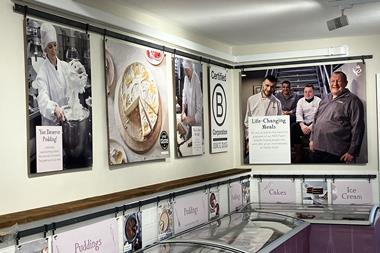Over 52 weeks, the major supermarket chains have battled to offer the cheapest prices, the best availability and the most outstanding service. In our annual review of the Grocer 33, Nick Hughes, Joanne Grew and James Ball ask those at the sharp end to reveal the secrets of their winning strategies
If Carlsberg did supermarkets, this year's model would probably look something like this. Shoppers would be greeted by a friendly assistant with a warm, Bradford lilt. She'd direct them towards a spotless aisle full of prodcts for £1, replete with green 'Smart Price' tags and bustling with shelf-stackers sporting green ties and yellow badges.
Or, to put it another way, Asda would set the prices and Morrisons would provide the staff and order the products. Because following Asda's clean sweep at last year's Grocer 33 awards, Morrisons has hit back, taking the honours for both customer service and availability.
The Grocer 33 annual review combines the results from the 52 weekly Grocer 33 shops carried out at each of the big five retailers (to be strictly accurate, the price monitoring continues for 52 weeks, but we take a two-week break from conducting mystery shopping results over Christmas).
And with recent switching data showing consumers have few qualms over mixing and matching their supermarket, this year's results acquire even greater significance.
Trading conditions over the past 12 months have been some of the most challenging ever experienced and price has been a key battleground. Yet, as our results show, on this count Asda remains untouchable. Its 12th consecutive Grocer 33 win puts to bed any lingering argument over who is Britain's cheapest retailer.
With the financial clout of Wal-Mart behind it, Asda was able to consistently undercut its rivals on our constantly changing basket of 33 goods, with a combination of sustained price promotions and Rollbacks.
But its aggressive promotions and range reviews have, in the eyes of some experts, come at the expense of Asda's availability, which slumped alarmingly in the 12 months to 6 June.
Asda and Tesco - arguably its biggest aggressor in the pricing arena - were rock bottom when it came to on-shelf availability and customer service, perhaps because high levels of promotional activity pose significant challenges for demand forecasters. Both Asda and Tesco fell well below the 97.5% level widely accepted as the industry benchmark. Morrisons, with its vertically integrated supply chain, coped far better with the challenge to get stock on shelf at the right time and edged the title from a rejuvenated Sainsbury's.
Asda's service also suffered. With just seven service wins to last year's 11 - epitomised by a painfully long average queuing time at the checkout - it appears the customer isn't always king at Asda.
Price: Nation's cheapest retailer increases the pricing gap
Winner: Asda
After a year dominated by pricing claims, from ‘Britain’s Biggest Discounter’ (Tesco) to ‘Switch and Save’ (Sainsbury's), from ‘Waitrose Essential’ to ‘Dinner for two for £10’ (M&S), you would expect the competition for The Grocer’s annual cheapest supermarket award to be closer than ever, right?
Wrong. Incumbent Asda sailed to a 12th successive victory in the Grocer 33 pricing survey, winning the cheapest supermarket award in 37 weeks out of 50, more than six times as frequently as its nearest rival. And despite new tactics, the other retailers in the Grocer 33 pricing survey maintained exactly the same ranking as last year.
A typical 33-item basket of shopping at Asda cost on average £52.96 over the past year, giving an annual food shopping total of £2,647.83. This was £67.31 less than the Morrisons’ annual total and £475.56 cheaper than the same items at Waitrose.
Asda actually managed to increase its pricing lead over other retailers. Last year, an Asda shop typically cost 98p a week less than second-placed Morrisons. This year, that gap grew to £1.34 and the price difference between Asda and all other retailers grew. Shopping at Tesco cost £1.84 a week more than Asda, Sainsbury's £2.91 more, and Waitrose had a hefty £9.51 premium over Asda.
Asda’s trading director Darren Blackhurst says keeping things simple and low-cost was the key to its success. The retailer has cut cost from its operations by removing ‘duplicate’ brands, streaming out pack sizes and trimming down ranges.
“We are very proud to win the Grocer 33 award for a 12th year. It’s taken an enormous effort from our colleagues and suppliers. There’s never been a more important time to win the cheapest supermarket award,” he added.
As Blackhurst likes to recall, Asda once sold eight different cheese graters. Now it stocks one, at £1, and sells more than the previous eight combined.
He also insisted the increased promotional and price-cutting activity from other retailers had made little difference to Asda’s pricing.
“I think we’ve always set the pace on price,” he says. “If not for Asda, I believe grocery prices in the UK would be higher, so there’s no extra pressure on us. We try to save customers money every day, not by making them save points on loyalty cards and wait to save money some other time. Asda is about permanence and prominence of value. We work to make sure customers can rely on Asda for low prices.”
Blackhurst says Asda will resist anything that makes its operations more complex or costly – such as stocking more pack sizes from brands looking to make a landgrab for shelf space.
Morrisons, the UK’s second-cheapest retailer, took the title for lowest-priced basket six times this year. Tesco, in third place, was also cheapest for six weeks this year, while Sainsbury's came fourth and was the cheapest shop in one week this year.
Waitrose was a distant fifth and, despite its new Essential range demonstrating its intention to strengthen its value-for-money credentials, its price premium over the big four actually grew.
Nielsen figures show promotions hit a record high this year, with almost one third of all supermarket sales made on promotion. Retailers have also changed their promotional tactics, with bogofs and multibuys declining over the year and money-off deals (particularly to round price points) significantly growing in popularity.
“The magic behind round-figure price cuts is their simplicity,” Blackhurst says. “If you observe customers as they shop, many total the cost of their shopping as they go. Clear price cuts make this a much simpler process for them.”
Despite all the talk of a price war, with so little movement, the combatants appear firmly entrenched, holding their positions.
And, having successfully held the line for 12 years, it will take one hell of a push to topple Asda in the year ahead.
Availability: A stable supply chain helps avoid gaps on shelves
Winner: Morrisons
Having lost out by a whisker to Asda in last year's availability contest, it was Morrisons' turn this time round to pip Sainsbury's to the title. And it inched ahead at the very death. A full basket in the final week compared with two out-of-stocks for Sainsbury's, saw Morrisons finish on 97.64%, a fraction down on last year, but 0.12 percentage points better than Sainsbury's - a difference of just two grocery items across an entire year.
Nonetheless, Sainsbury's improved by an impressive 1.01 percentage points on 2008, vindicating the significant changes Justin King has made to improve its supply chain.
Waitrose performed marginally better than last year with 97.26% availability, an improvement of 0.22 percentage points. Tesco's out-of-stocks slipped almost half a percentage point and, at 96.03%, fell short of the widely accepted 97.5% industry benchmark. The biggest loser was last year's winner, Asda, down more than 1.5 points to 96.23%.
The stability of Morrisons' supply chain compared with its rivals helps it maintain consistently high levels of availability, says Colin Harper of Storecheck marketing. "Morrisons has always had a very conservative policy towards what it stocks, when and how it stocks it, and it hasn't indulged in beating up suppliers to anywhere near the extent of Asda and Tesco - at least publicly. I would say stability in its supply chain may be helping to keep it top of the heap."
Morrisons' director of retail, Mark Gunter, points to the growing influence of technology as another reason for the retailer's success. "In the past 12 months, we have rolled out a new ordering system on ambient goods. It was a big move for us. Anything we sell less than one case of a week is automatically ordered so it gives staff more time to focus on other areas. We are also rolling out voice picking in our depots rather than walking up the aisles and picking - an automated system tells you what to pick to improve efficiency, speed quality and accuracy."
Sainsbury's, which has notoriously struggled to match the availability of its rivals in recent times, is also using technology to improve the efficiency of its supply chain and has recently outsourced electronic trading with all of its 4,000 suppliers to supply chain specialist WeSupply. "Sainsbury's is automating its orders, invoices, shipping information and goods-received information with 4,000 suppliers, because people make mistakes ," says Anthony Payne, VP of marketing at WeSupply.
Indeed, technology is playing an increasingly important role in managing availability during a recessionary period characterised by aggressive promotional strategies. New forecasting methods using statistical algorithms are able to accurately predict the uplift in sales of promotional items and ensure retailers are prepared . Not only that, but new systems are able to assess the effect of economic conditions and calculate changing demand accordingly. "Some of the less sophisticated systems out there would not consider the downturn," says Richard Nicholas, sales director at TXT e-solutions, a supply chain vendor whose clients include Weetabix, Young's and Grampian.
"In these days of difficult economic climates you need to be able to implement and get results very quickly. Three weeks and a 5% increase in forecast accuracy is pretty significant. Typically we would hope for a 6% improvement in forecast accuracy immediately, and then, with other work and process improvement, you could probably drive that up by another 10 points."
The software is coming into its own in the downturn as consumers become more promiscuous. "Shopper behaviour is changing," says Karen Chalmers, senior business analyst at IGD. "People are shopping around for better deals and this presents challenges."
Chalmers points to variable weather and the influence of celebrities such as Jamie Oliver and Delia Smith as factors that can catch out demand forecasters.
But for all the advances in supply chain technology in recent years, human error is most commonly at the heart of poor availability. "There are hundreds of root causes of poor availability, but I think it remains true that the biggest issue continues to be the management of products once they reach the store," says Don Brenchley, consultant at JDA Software. "You can be right in your forecasting and actually in the creation of a perfect order for the store, but it's how that product is handled between the back of the store and the front of the store that drives a lot of on-shelf availability issues today."
Professor David Grant, director of Hull University Business School Institute of Logistics, agrees that there's often a disconnect between the processes that take stock into stores and the in-store management of stock. "The process of getting the stock to store is pretty good. The problem is usually with the last 50 yards. In our studies, we've seen evidence of stuff hidden in the back of the stock room for days."
So what can we expect from next year's G33 availability survey? Successive years of availability around the 97.5% mark begs the question - should Morrisons be aiming to break the 98% mark next year? Nicholas believes not. "The higher you aim for availability, the higher the cost is. It's a pure exponential curve. It's a trade-off decision that companies have to make and 97.5% seems to be the point that commercially everyone seems to have decided is acceptable."
"For some items, it makes no sense for it to be in stock at all times," Brenchley concurs. "But for others the maths works out much more favourably. Those systems that have the technology to allow you to balance investment costs against availability costs are the ones that are moving forward."
Service: Kim steals it for Morrisons with last-gasp till tally
Winner: Morrisons
Morrisons can thank its new queue management system, and Kim - a checkout assistant at the Almondvale, Livingston store - for its victory in this year's Service award. With one week to go, Morrisons was running neck and neck with Waitrose, with 13 wins apiece in our weekly store award. But a two minute queue, Kim's speedy scanning technique, and an offer to pack the 33 items saw Mike Shaw's Edinburgh-based branch win in the final week of this year's competition, to inch ahead of Waitrose.
Asked why Morrisons won, group retail director Mark Gunter said its Visions and Values programme had raised the bar for customer service levels. The retailer's new Give Me Five scheme is also proving effective, he claims. It is designed to motivate and focus staff by informing them of what is happening in the company.
He also praises Morrisons' Fresh Food Academy, which was launched in February and offers apprenticeships to butchers, bakers and fishmongers on its Market Street counters. This would ensure that Morrisons remained "The Food Specialist for Everyone," says Gunter.
"The Fresh Food Academy enables us to make the most of our staff and their skills to offer great service. We are getting younger people into traditional crafting skills." The retailer is on track to sign up 18,000 apprentices this year, he added.
The use of checkout managers, a role unique to Morrisons, according to Gunter, has also improved checkout times and the quality of customer service at the checkout; while the innovation team ensured that feedback from customers is implemented at local and national level.
While it lost out by a whisker, Waitrose also deserves credit for achieving four more weekly wins than last year. At the half-way stage, in December, Waitrose had already recorded eight weekly store wins, so it will be all the more determined to avoid this year's near miss and secure the victory next time.
Finally, while all retailers had a slower average checkout time than last year, Waitrose once again had the fastest till service and Tesco retained its 2008 position with the second-quickest service.

















No comments yet